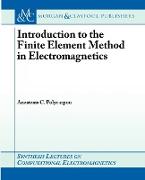- Start
- Introduction to the Finite Element Method in Electromagnetics
Introduction to the Finite Element Method in Electromagnetics
Angebote / Angebote:
This series lecture is an introduction to the finite element method with applications in electromagnetics. The finite element method is a numerical method that is used to solve boundary-value problems characterized by a partial differential equation and a set of boundary conditions. The geometrical domain of a boundary-value problem is discretized using sub-domain elements, called the finite elements, and the differential equation is applied to a single element after it is brought to a "weak" integro-differential form. A set of shape functions is used to represent the primary unknown variable in the element domain. A set of linear equations is obtained for each element in the discretized domain. A global matrix system is formed after the assembly of all elements. This lecture is divided into two chapters. Chapter 1 describes one-dimensional boundary-value problems with applications to electrostatic problems described by the Poisson's equation. The accuracy of the finite element method is evaluated for linear and higher order elements by computing the numerical error based on two different definitions. Chapter 2 describes two-dimensional boundary-value problems in the areas of electrostatics and electrodynamics (time-harmonic problems). For the second category, an absorbing boundary condition was imposed at the exterior boundary to simulate undisturbed wave propagation toward infinity. Computations of the numerical error were performed in order to evaluate the accuracy and effectiveness of the method in solving electromagnetic problems. Both chapters are accompanied by a number of Matlab codes which can be used by the reader to solve one- and two-dimensional boundary-value problems. These codes can be downloaded from the publisher's URL: www.morganclaypool.com/page/polycarpou
Folgt in ca. 15 Arbeitstagen
